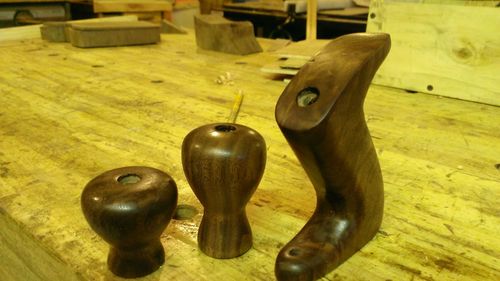Plane restores, expect the unexpected.
February 23, 2014 3 Comments
I’ve gone through a few plane restores in the past. As time has passed I’ve learned a respect for the history and patina of some old and rare planes, but bringing planes back from the brink is still a lot of fun for me.
I don’t really have a good before picture of this plane, simply because it was never intended to be restored. My goal for this plane was to see if I could salvage enough beech out of the middle of the deteriorated mess to use for repairs on future plane restores.
–

–
It came from an antique store. I got this whole pile for close to nothing.
–

–
So the first thing I did was pop the handle off. It came off fairly easy and what was left came out in one piece. My next move was to run it through the planer. Starting very thin, I wanted to save as much of the beech as I could.
After the very first pass, my intentions started to change. I wish I’d taken a few more pictures along the way, but you can see the results.

I cut about a half inch off the front. I’ll save it because the name is on it. I wish it could have been saved in place, but I was very surprised I didn’t have to take a lot more off.
Its hard to make out, but I believe its Randall and Cook, Albany NY. There is not much online about them other then a few other vintage planes for sale. Everything I found was wood bodies, so I’m assuming they were early.







The cutter took a little work, but its a Maulson Bros. iron and is pretty hard. It was wedged in so hard I had to drive it out with a punch, which made sharpening even that much harder.
The plane could be put back into service, but I doubt I will ever use it. I think it deserves a rest and it will look nice with the rest of the wooden rescues I have collected.







































































